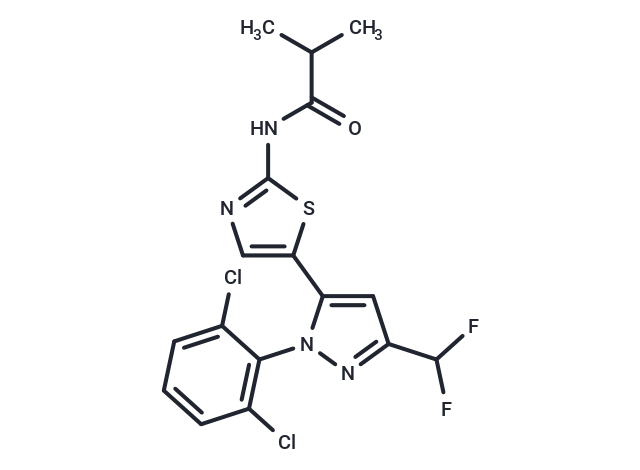Shopping Cart
- Remove All
 Your shopping cart is currently empty
Your shopping cart is currently empty

BMS-5 (LIMKi 3) is a highly potent LIMK inhibitor, exhibiting IC50 values of 7 nM for LIMK1 and 8 nM for LIMK2.

| Pack Size | Price | Availability | Quantity |
|---|---|---|---|
| 1 mg | $36 | In Stock | |
| 2 mg | $50 | In Stock | |
| 5 mg | $76 | In Stock | |
| 10 mg | $125 | In Stock | |
| 25 mg | $209 | In Stock | |
| 50 mg | $313 | In Stock | |
| 100 mg | $467 | In Stock | |
| 1 mL x 10 mM (in DMSO) | $84 | In Stock |
| Description | BMS-5 (LIMKi 3) is a highly potent LIMK inhibitor, exhibiting IC50 values of 7 nM for LIMK1 and 8 nM for LIMK2. |
| Targets&IC50 | LIMK1:7 nM, LIMK2:8 nM |
| In vitro | BMS-5 inhibits cofilin-Ser3 phosphorylation in a dose-dependent manner in Nf2ΔEx2 mouse Schwann cells (MSCs) with an IC50 of ~2 μM. BMS-5 reduces Nf2ΔEx2 MSC viability in a dose-dependent manner with an IC50 of 3.9 μM, but does not significantly reduce the viability of control Nf2flox2/flox2 MSCs at equivalent BMS-5 concentrations. At 10 μM BMS-5, Nf2ΔEx2 MSC viability is 40% compared to 83% for controls[2] . |
| In vivo | BMS-5 (20 or 200 μM/side) was administered bilaterally into the hippocampi of rats immediately following contextual fear conditioning training. Memory consolidation was assessed 48 hours after the conditioning through tests measuring freezing behavior. Analysis revealed that rats receiving the 200 μM dose of BMS-5 exhibited significantly reduced freezing compared to those treated with 20 μM and the control group [P]. |
| Kinase Assay | The protein kinase domains of human LIMK1 and LIMK2 are expressed as glutathione S-transferase fusion proteins using the Bac-to-Bac system in Sf9 cells. Compounds 1 to 6 (e.g., BMS-5) are assayed for inhibition of LIMK1 and LIMK2 protein kinase activity by radioactive phosphate incorporation into biotinylated full-length human destrin. Reactions are done with a concentration series of compound in 25 mM HEPES, 100 mM NaCl, 5 mM MgCl2, 5 mM MnCl2, 1 μM total ATP, 83 μg/mL biotinylated destrin, 167 ng/mL glutathione S-transferase-LIMK1, or 835 ng/mL glutathione S-transferase-LIMK2 in a total volume of 60 μL at room temperature for 30 min (LIMK1) or 60 min (LIMK2). Reactions are terminated by addition of 140 μL of 20% TCA/100 mM sodium pyrophosphate, and the precipitates are harvested onto GF/C unifilter plates. The radioactivity incorporated is determined using a TopCount after addition of 35 μL Microscint scintillation fluid[1] |
| Cell Research | Cell membrane asymmetry is measured. Nf2ΔEx2 MSCs plated in a 6-well format are incubated with 2 μM BMS-5 or DMSO vehicle for 24 hrs. Cell are harvested and assayed. Plasma membrane asymmetry is evaluated with the Violet ratiometric assay by flow cytometry[2] . |
| Animal Research | Rats [3] |
| Alias | LIMKi 3, BMS5 |
| Molecular Weight | 431.29 |
| Formula | C17H14Cl2F2N4OS |
| Cas No. | 1338247-35-0 |
| Smiles | CC(C)C(=O)Nc1ncc(s1)-c1cc(nn1-c1c(Cl)cccc1Cl)C(F)F |
| Relative Density. | 1.54 g/cm3 (Predicted) |
| Storage | Powder: -20°C for 3 years | In solvent: -80°C for 1 year | Shipping with blue ice. | |||||||||||||||||||||||||||||||||||
| Solubility Information | DMSO: 55 mg/mL (127.52 mM), Sonication is recommended. | |||||||||||||||||||||||||||||||||||
Solution Preparation Table | ||||||||||||||||||||||||||||||||||||
DMSO
| ||||||||||||||||||||||||||||||||||||

Copyright © 2015-2025 TargetMol Chemicals Inc. All Rights Reserved.